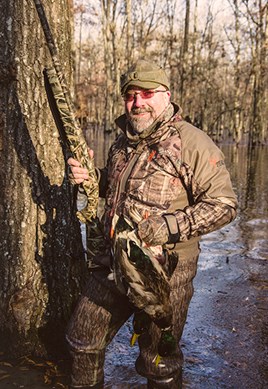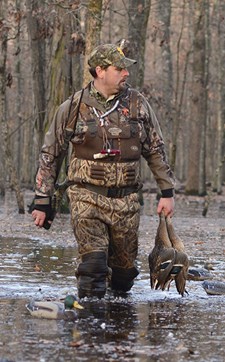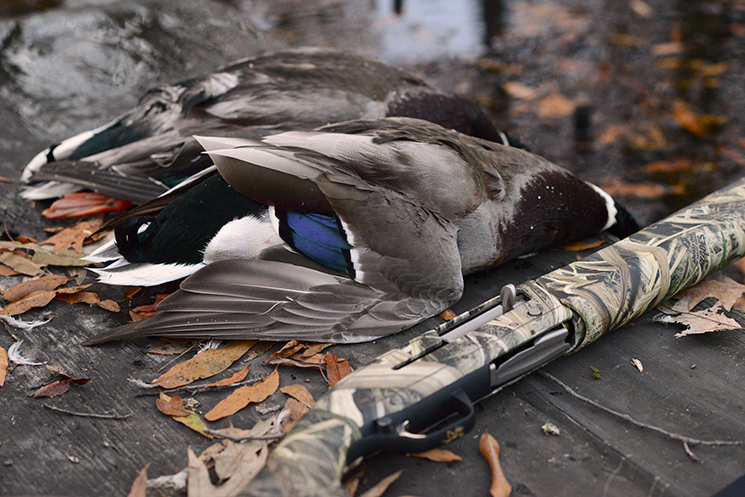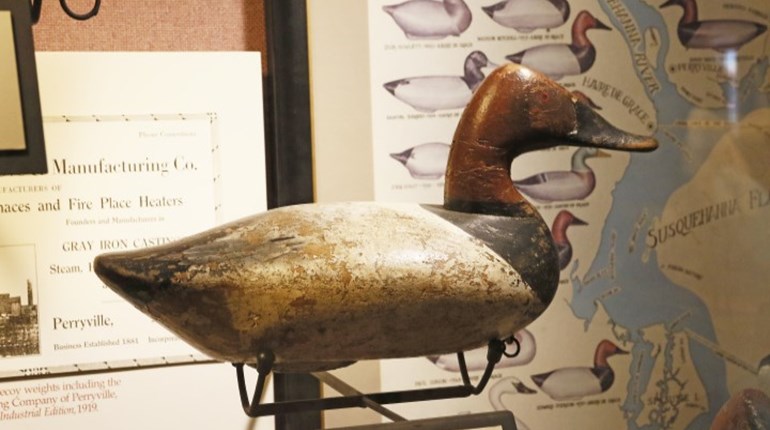
In predawn darkness, half a dozen hunters lean against oaks towering above still, black water. Other than the occasional ripple created when somebody shifts weight off a sunken tree limb, the only noise present is the sound of the wings on the spinning decoy in our spread.
Tim Doepel begins to call—soft quacks, as if to say to the ducks circling above us, “C’mon, folks, plenty of acorns and safety down here.”
Soon, five mallards drop through the trees before us.
Tim stops calling and quietly, matter-of-factly says, “Take ’em.”
Boom! Boom, ba-boom, boom, boom! Boom! The blasts clap off the water and roll through the timber like thunder.
As the shooting ends, we shuck in more shells and furtively exchange appreciative glances. It’s as if each of us is saying, “Did you see that? They dropped right in front of us and … ”
More ducks drop in so quickly we’re caught with hands on shells and thumbs in magazines. We’re not ready. Then we all realize the obvious: No one fired more than a round or two at the first group. So we unload again.
Boom, boom, ba-boom boom! Boom! Boom! Ba-boom, boom!
Six more ducks are added to the first five. How can anyone miss in here? The ducks are so close I could butt stroke them with the Browning.
 Over the next hour, when we dare to expose white faces, we sneak looks skyward. Mallards—many of them—sail overhead. We kick the water to give movement to the decoy spread when we think the action is slowing. But the truth is it is not slowing. In fact in about an hour six of us limit out with six ducks apiece. Most are mallards. Add in five ducks apiece for each of our two guides, and it’s clear this is a good morning. Forty-six ducks in an hour: This is something waterfowlers everywhere hear about, dream about but rarely experience firsthand. It’s the reason I came here.
Over the next hour, when we dare to expose white faces, we sneak looks skyward. Mallards—many of them—sail overhead. We kick the water to give movement to the decoy spread when we think the action is slowing. But the truth is it is not slowing. In fact in about an hour six of us limit out with six ducks apiece. Most are mallards. Add in five ducks apiece for each of our two guides, and it’s clear this is a good morning. Forty-six ducks in an hour: This is something waterfowlers everywhere hear about, dream about but rarely experience firsthand. It’s the reason I came here.
A Grand Grassland Beckons
Welcome to the Grand Prairie. Located between the bottomlands of the White and Arkansas rivers, it is a sub-region of the Mississippi Delta in eastern Arkansas. At one time it was an immense area of native grassland stretching across Prairie, Lonoke and Monroe counties, surrounded by the swampy Delta land.
Today the native grassland is no longer so distinct, due mainly to clear-cutting and settlement. However, the region still produces and houses two things in abundance: rice and ducks.
Native Americans lived and hunted here. Pottery adorned with ducks dating to 1100 sits in the Museum of the Arkansas Grand Prairie, in Stuttgart. As early as 1819, settlers thought the 900,000 acres of the Prairie was “truly inexhaustible” pastureland. So they plowed it to plant corn or wheat. Some tried cotton, but the land was not ideal for the cash crop and so the region lagged behind other parts of the state. This hardly deterred settlement. European-American immigrants were attracted to a place where they could raise cattle and cut hay. German settlers founded Stuttgart in 1878. In the 1890s, Slovaks established the town of Slovak, in Prairie County.
Soon thereafter, hay was replaced as the crop of the region.
Beneath the Prairie’s topsoil lies a deep layer of dense clay impenetrable by water, as opposed to the alluvial soils of the Delta. However, beneath that clay lay what seemed to be an inexhaustible supply of groundwater from the Mississippi River Valley Alluvial Aquifer. That made it ideal for a crop like rice, which requires flooding to cultivate.
Rice cultivation began in earnest here in 1897. By 1906, 4,000 acres of the Prairie were planted in rice; the state’s first rice mill was built the next year. Now, rice requires 33 inches of water during its growing season. So to supply such irrigation, farmers drilled wells to tap the aquifer. By the dawn of World War I, more groundwater was being pumped to irrigate 100,000 acres of rice than could be replaced by natural processes. Soon, lowering of the water level in the Alluvial Aquifer raised concerns, and in 1931 a study by the U.S. Geological Survey linked cause and effect. But this didn’t deter rice farmers who began pumping from the nearby Sparta Sands Aquifer. And federal agricultural incentives during World War II only increased rice production.
To mitigate some of these problems, the Flood Control Act of 1950 authorized the U.S. Army Corps of Engineers to supply rice farmers with water from the White River. The plan to draw 100 billion gallons a year from the river faced resistance that continued until at least 2011. Today, less than 1 percent of the original native grassland remains.
Onto this landscape in the 1930s strode Edgar Monsanto Queeny, who was born in 1897, the year rice production began on the Prairie. He served in the U.S. Navy in World War I, earned a chemistry degree from Cornell in 1919 then went to work for the family business: Monsanto Chemical Company, started by Edgar’s father in 1901 with $5,000. Edgar became president of the company in 1928, and by the time he retired in 1960, he’d built Monsanto into the third-largest chemical company in the nation and the fifth-largest such enterprise in the world.
His pastime—indeed, his passion—was duck hunting. Beginning in the early 1930s, Queeny and his wife, Ethel, residents of St. Louis, began making frequent trips to the Grand Prairie, staying in a travel trailer. It’s said that Ethel “could handle a shotgun as well as her husband,” but apparently she couldn’t handle living out of a trailer. It’s also said she gave Edgar an ultimatum: Find suitable quarters or he could count her out on future forays to Arkansas. He did so in 1937.
Queeny had been hunting the Mill Bayou near DeWitt with Elmer “Tippy” LaCotts and Jess Wilson, reputedly the state’s best duck caller in the 1930s. Queeny liked the land in Arkansas County, and so he purchased 11,000 acres on LaGrue Bayou. Hard feelings still linger over the way he acquired some of it.
Verne Tindall’s Reservoir, built in 1927 near Stuttgart, paved the way toward increased rice production in the face of lowered water tables. By then, wells had to be dug twice as deep as only 30 years prior. Tindall’s solved that. It also attracted even more ducks thanks to shallow lakes built to hold water for rice irrigation.
Queeny, sensing a grand opportunity, formed the Arkansas Irrigation Company and proposed to build a 3,500-acre reservoir on LaGrue Bayou to augment Tindall’s—and used eminent domain to secure the necessary acreage not already owned or purchased outright. In the midst of the Great Depression, many Slovak farmers were forced to sell some parcels to make room for what would become Peckerwood Lake, so named by Ethel, who noted the many woodpeckers that thumped the standing dead timber when the impoundment was completed in 1942.
In 1939, Queeny commissioned Frederick Wallace Dunn, a St. Louis architect and Yale graduate, to design a colonial revival mansion on the property. The 10,000-square-foot home has nine bedrooms and nine bathrooms, and two wings with a formal dining room. Queeny named the estate Wingmead, a word of Scottish origin that means “meadow of wings.”
He was by no means done. He built three green-tree reservoirs—Wingmead, Greenwood and Paddlefoot—covered with pin oaks to be flooded seasonally for the purpose of attracting ducks for hunting. However, Peckerwood was reserved as sanctuary for resting waterfowl.
Queeny now had a duck club that enabled him to shoot a limit of mallards only moments from his mansion. Indeed, pictures still hanging in the mansion show Edgar and Ethel in a blind: Behind them, their guide stands in almost formal dress. Word spread. Over the years, dignitaries beat a path to Wingmead; included among them were the famous outdoor writer Nash Buckingham, wildlife illustrator Richard Bishop and Walt Disney. Guests were expected to dress for dinner. Queeny tackled his business and his pastime with equal fervor, even mixing the two. Often, he flew down Monsanto staff from St. Louis on his private plane. He hunted ducks in the morning then held a board meeting before Monsanto staff returned to the city.
 Queeny was keenly interested in the flight of ducks. It was at Wingmead where he wrote the book Prairie Wings, published by Ducks Unlimited in 1946. The seminal work is still unequaled as a study of ducks in flight. It was illustrated by Bishop, then one of the country’s best wildlife artists.
Queeny was keenly interested in the flight of ducks. It was at Wingmead where he wrote the book Prairie Wings, published by Ducks Unlimited in 1946. The seminal work is still unequaled as a study of ducks in flight. It was illustrated by Bishop, then one of the country’s best wildlife artists.
Edgar Queeny died in 1968. Thereafter his widow, Ethel, maintained the estate until her death in 1975, whereupon it was willed to Barnes Hospital in St. Louis. In 1976, Barnes sold Wingmead via sealed bid. Rumored suitors included Anheuser-Busch and celebrities Johnny Cash and Elvis Presley. However, the Lyon family of Arkansas won the bidding. Today, the farm is still owned and operated by Frank and Jane Lyon not only as a hunting lodge but also as one of the most successful producers of rice, soybeans and wheat on the Grand Prairie.
Wingmead is not the only club on the Grand Prairie, but it’s the jewel of the region—that much is sure. Today it encompasses 14,000 acres, and is the centerpiece on a landscape that has attracted migrating ducks and geese for centuries.
Paradise Preserved
In light of so much history, the Grand Prairie’s reputation among duck hunters is not surprising. Folks travel from near and far to get a crack at ducks over rice fields and ducks winging through hardwood bottoms flooded seasonally by overflow from the White and Cache rivers. Waterfowl of the Mississippi Flyway have for the past 90-plus years been rewarded during stopovers here by the region’s improved rice cultivation.
I first hunted the region more than a decade ago. Though I couldn’t call myself much of a waterfowler then, I’d heard of Stuttgart and knew an invitation to hunt there was not to be refused. Problem was, my gun and gear did not make it to Little Rock in time to shove off for our lodge, and so I hunted with begged and borrowed clothing, guns and ammo. We hunted from a blind above standing water one morning, and shared a pit in a rice field with then-Gov. Mike Huckabee on another. On the way back to Little Rock, I picked up my duffel and gun case at Mack’s Prairie Wings, the famous sport shop of Stuttgart known by waterfowlers nationwide for its thriving catalog commerce.
My second hunt on the Prairie didn’t include ducks at all. A group of us traveled to Wingmead to shoot deer. I didn’t mind, for only a year prior AH Field Editor Bryce Towsley had shot his best-ever buck here, and I had dreams of doing the same. That didn’t happen, but something else did: As the trip waned and I took in all the history the famous farm held, I knew any return to it must include an opportunity to stand in flooded timber and watch greenheads drop into a spread.
That happened last year, as described at the outset.
It is said Wingmead hosts the largest concentration of wintering mallards in the country, and my observations can find no falsehood in that statement. Peckerwood remains an important winter rest area. In fact most of the waterfowl hunted on the Prairie use the lake at one time or another during their winter stay.
Its green-tree reservoirs—Greenwood, Paddlefoot and Wingmead—are flooded seasonally with releases from Peckerwood. We hunted Greenwood that first morning. The practice, begun by Queeny, is today enhanced by a wildlife management program implemented by the Lyons that includes a rice and bean farming operation. They are forever improving habitat, creating food and protection for every species that calls Wingmead home. Everything perpetuates a waterfowl paradise.
When the Lyons bought the place everything was included: the land, the house and outbuildings, the furniture, artwork—everything. The artwork includes original paintings by Bishop. A duck illustration by him became the official logo of Wingmead, which graces the china and glassware. The mansion contains the only complete, original collection of every duck stamp and painting that inspired it I have ever seen. Old logbooks in the main house date to the late 1930s and contain passages from many famous guests, among them Buckingham of Mississippi, who wrote that his party enjoyed a memorable morning in Greenwood and returned to the main house before 8 a.m. Sounds a lot like our shoot the first morning.
Indeed, little has changed here. Room for the airstrip Queeny had cut in the rows of trees that line the driveway is still visible. Guests still spend the night in the main house, which feels a little like a scene from “Night at the Museum.” They still are expected to sign the logbook; an entry by yours truly now graces the pages twice. However, guests are not expected to dress for dinner, which is good because our group last year could not have mustered the necessary garb. Today, Wingmead sits on the National Register of Historic Places.
Hail, the Mallard
The second morning, we each pick a tree to lean against in Paddlefoot.
The handful of times I’ve hunted ducks exclusively it’s been over big water, or maybe while huddled in a small blind in the midst of a vast field. Either way, in such setups it’s necessary to get the ducks’ attention across a vast sky. To do that, usually a loud hail is in order. If they look down, lock on your setup, you might then throw in some soft quacks to keep their attention.
The opposite is true in flooded timber. Here, you need to start softly. If ducks circle overhead but don’t commit then hail, sure, but keep it down. Throw in some louder chuckle and feed calls to get and/or keep their attention only when the action becomes fast and steady.
In Paddlefoot, we watch ducks circle wide but they won’t commit. So Tim Doepel, Wingmead’s “jack of all trades” wearing a lanyard covered in leg bands, starts with soft hails. Of course: Every sound carries in the timber. Why hail loudly when the birds are right above you?
Soon enough, Doepel utters his quiet command: “Take ’em.” I shoulder the Browning Maxus and fire. Others do, too. However, the ducks don’t drop across our spread as they did in Greenwood but instead land to our right, so not everyone gets a shot.
Later, as the action heats up, Doepel switches to rapid feeding calls. Subsequent drop-ins ensure everyone gets in some shooting. I get more than I need, and so I exchange gun for camera. Then we quit.
Typically, flooded timber is hunted only in the morning. Laying off the ducks in the afternoon provides a place for them to rest undisturbed for the remainder of the day. No one complains. We haven’t reached our limit so quickly this morning—it has taken us about 90 minutes, not 60—but smiles abound. Among all the mallards, as there was the day before, is a handful of green-winged teal, gadwalls, wood ducks and wigeons. No one will go home empty-handed.
Everyone gives thanks. You see, Wingmead is not open to the public; one must be invited to hunt here. Indeed, I can convey such an honor only vicariously through these words. I hope I’ve done the place proud because it’s doubtful I’ll ever return, for one cannot count on boundless graciousness. However, one can count on the rice growing and the timber flooding on the Grand Prairie, and the mallards returning to the meadow of wings again and again.






































